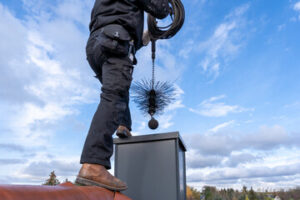Chimney sweep is someone who cleans the ash and embers from chimneys. A chimney uses a pressure difference created by a hot column of gas to draw air over hot coals or wood. The chimney may be straight or have many twists and turns.

When people burn wood in a fireplace, creosote gas forms, this substance is a product of the wood-burning process, releasing gases that can condense and stick to the walls of the chimney. It can take several forms, including tar-like, crusty, and sticky. As it builds up, it can contribute to a number of health problems, including the onset of cancer.
To make sure the fireplace is clean of creosote, you should have your chimney swept on a regular basis. This will prevent creosote buildup. The wood you burn needs proper airflow in order to burn completely. Once it cools, it combines with humidity to form an oily residue called creosote. This substance is highly flammable and can ignite easily when a stray ember sparks it.
When creosote builds up in your chimney, it becomes a danger for your home. Not only does it contribute to fire hazards, but it can also damage your eyes and respiratory system. Whether you’re working on a fireplace or a wood-burning appliance, creosote can expose you to harmful fumes and irritate your skin.
Creosote is a coal tar product that contains many carcinogenic and mutagenic chemicals. These include benzene and polycyclic aromatic hydrocarbons. It is regulated in the marketing of creosote products and their preparations. However, it is not required to warn consumers about these substances unless the benzene content is less than a thousand parts per million.
It is important to have your chimney professionally cleaned annually. This will help maintain the proper airflow and reduce the likelihood of a chimney fire. Using a certified chimney sweep can ensure that your chimney is safe and sanitary. In addition, they can identify potential fire indicators. They can also help you determine how much cleaning and inspection your chimney needs. If you have a chimney with excess creosote, the risk of fire is increased.
Soot is a particulate matter, black in color, produced by the incomplete burning of organic materials. It is known to contain carcinogens and is a hazardous substance for human health. People are exposed to soot through ingestion, skin absorption, and inhalation. Chimney sweeps probably experience the greatest occupational exposure to soot. The general public is also exposed to engine exhaust, which can come from any type of combustion source.
To properly clean chimneys, you must ensure that they are not blocked by debris or other obstructions. This will reduce the risk of fires. The first step in cleaning chimneys is to ensure that there are no bird nests inside the flue. Another important step is to cover the firebox and ensure that the firebox is closed tightly.
After the fireplace has been closed, inspect it with a flashlight to ensure that you can see all the areas of soot. If you notice that the entire area is black or has a deep scratch, stop using the fireplace immediately and contact a chimney sweep. The cleaner will restore the flow of air in the home.
Whether you prefer a professional chimney sweep or a DIY method, a chimney sweep will help keep your home free from dangerous deposits. Soot can affect the functioning of your fireplace, so it is important to regularly clean your chimney. It can be challenging to clean a chimney that is on the outside of your house, but a chimney professional will be able to remove dangerous deposits.
While it is not common now, chimney sweeping was a popular profession in the 18th century. Boys as young as four years old were often hired as chimney sweeps. They were often paid by the amount of soot they removed from the chimney. In addition, they often slept under a soot sack. Children who became soot sweeps were often unable to wash themselves properly.
If you’re experiencing a smoky smell coming from your chimney, you may want to get your chimney swept. Smoke is a natural byproduct of burning fire, but a blockage in your chimney may not be able to properly exit the chimney. This can cause bigger problems, such as fireplace back puffing.